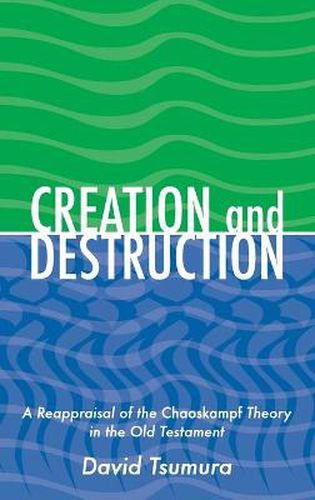Readings Newsletter
Become a Readings Member to make your shopping experience even easier.
Sign in or sign up for free!
You’re not far away from qualifying for FREE standard shipping within Australia
You’ve qualified for FREE standard shipping within Australia
The cart is loading…






In 1989, David Tsumura published a monograph entitled The Earth and the Waters in Genesis 1 and 2: A Linguistic Evaluation, in which he demonstrated that the oft-recited claim that the early chapters of Genesis betrayed a background or adaptation by Israel of mythological terms and/or motifs from other ancient Near Eastern literature could not be supported by a close examination of the linguistic data. Despite the book’s positive reception, the notion that the Chaoskampf motif lies behind the early chapters of Genesis continues to be rehearsed in the literature as if the data were incontrovertible.
In this revised and expanded edition of the 1989 book, Tsumura carries the discussion forward. In part 1, the general thesis of the original work is restated in a significantly revised and expanded form; in the second part of this monograph, he expands the scope of his research to include a number of poetic texts outside the Primeval History, texts for which scholars often have posited an ancient Near Eastern mythological substratum. Among the questions asked are the following: What are the functions of waters and flood in biblical poetry? Do the so-called chaos dragons in the Old Testament, such as Leviathan, Rahab, and Yam, have anything to do with the creation motif in the biblical tradition? What is the relationship between these poetic texts and the Ugaritic myths of the Baal-Yam conflict? Are Psalms 18 and 29 adaptations of Canaanite hymns, as suggested by some scholars?
Among the conclusions that Tsumura reaches are these:
(1) The phrase tohu wabohu has nothing to do with the idea of a chaotic state of the earth.
(2) The term tehAm in Gen 1:2 is a Hebrew form derived from the Proto-Semitic *tiham-, ocean, and it usually refers to the underground water that was overflowing and covering the entire surface of the earth in the initial state of creation.
(3) The earth-water relationship in Gen 2:5-6 is different from that in Gen 1:2. In Gen 1:2, the earth was totally under the water; in Gen 2:5-6, only a part of the earth, the land, was watered by the ‘ed-water, which was overflowing from an underground source.
(4) The biblical poetic texts that are claimed to have been influenced by the Chaoskampf-motif of the ancient Near East in fact use the language of storms and floods metaphorically and have nothing to do with primordial combat.
$9.00 standard shipping within Australia
FREE standard shipping within Australia for orders over $100.00
Express & International shipping calculated at checkout
In 1989, David Tsumura published a monograph entitled The Earth and the Waters in Genesis 1 and 2: A Linguistic Evaluation, in which he demonstrated that the oft-recited claim that the early chapters of Genesis betrayed a background or adaptation by Israel of mythological terms and/or motifs from other ancient Near Eastern literature could not be supported by a close examination of the linguistic data. Despite the book’s positive reception, the notion that the Chaoskampf motif lies behind the early chapters of Genesis continues to be rehearsed in the literature as if the data were incontrovertible.
In this revised and expanded edition of the 1989 book, Tsumura carries the discussion forward. In part 1, the general thesis of the original work is restated in a significantly revised and expanded form; in the second part of this monograph, he expands the scope of his research to include a number of poetic texts outside the Primeval History, texts for which scholars often have posited an ancient Near Eastern mythological substratum. Among the questions asked are the following: What are the functions of waters and flood in biblical poetry? Do the so-called chaos dragons in the Old Testament, such as Leviathan, Rahab, and Yam, have anything to do with the creation motif in the biblical tradition? What is the relationship between these poetic texts and the Ugaritic myths of the Baal-Yam conflict? Are Psalms 18 and 29 adaptations of Canaanite hymns, as suggested by some scholars?
Among the conclusions that Tsumura reaches are these:
(1) The phrase tohu wabohu has nothing to do with the idea of a chaotic state of the earth.
(2) The term tehAm in Gen 1:2 is a Hebrew form derived from the Proto-Semitic *tiham-, ocean, and it usually refers to the underground water that was overflowing and covering the entire surface of the earth in the initial state of creation.
(3) The earth-water relationship in Gen 2:5-6 is different from that in Gen 1:2. In Gen 1:2, the earth was totally under the water; in Gen 2:5-6, only a part of the earth, the land, was watered by the ‘ed-water, which was overflowing from an underground source.
(4) The biblical poetic texts that are claimed to have been influenced by the Chaoskampf-motif of the ancient Near East in fact use the language of storms and floods metaphorically and have nothing to do with primordial combat.